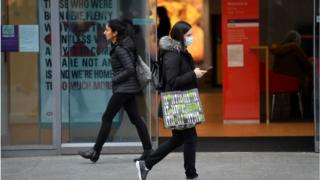 Image copyright
Dan Mullan
Image copyright
Dan Mullan
The UK's inflation rate fell to 0.5% in May, the second full month of the coronavirus lockdown, as most shops were shut by the pandemic.
The Consumer Prices Index (CPI) fell from 0.8% in April, the Office for National Statistics (ONS) said.
Supermarkets were among the few shops allowed to open during the month and food prices rose.
However, this was offset by a fall in clothing and footwear prices, as well as cheaper petrol, the ONS said.
"The growth in consumer prices again slowed to the lowest annual rate in four years," said ONS deputy national statistician for economic statistics Jonathan Athow.
"The cost of games and toys fell back from last month's rises, while there was a continued drop in prices at the pump in May, following the huge crude price falls seen in recent months.
"Outside these areas, we are seeing few significant changes to the prices in the shops."
The ONS admitted that it had difficulty compiling inflation statistics for May, since many areas of the economy were completely shut down.
For instance, inflation figures for holidays had had to be "imputed", it said.
What is inflation?
Inflation is the rate at which the prices for goods and services increase.
It's one of the key measures of financial wellbeing because it affects what consumers can buy for their money. If there is inflation, money doesn't go as far.
It's expressed as a percentage increase or decrease in prices over time. For example, if the inflation rate for the cost of a litre of petrol is 2% a year, motorists need to spend 2% more at the pump than 12 months earlier.
And if wages don't keep up with inflation, purchasing power and the standard of living falls.